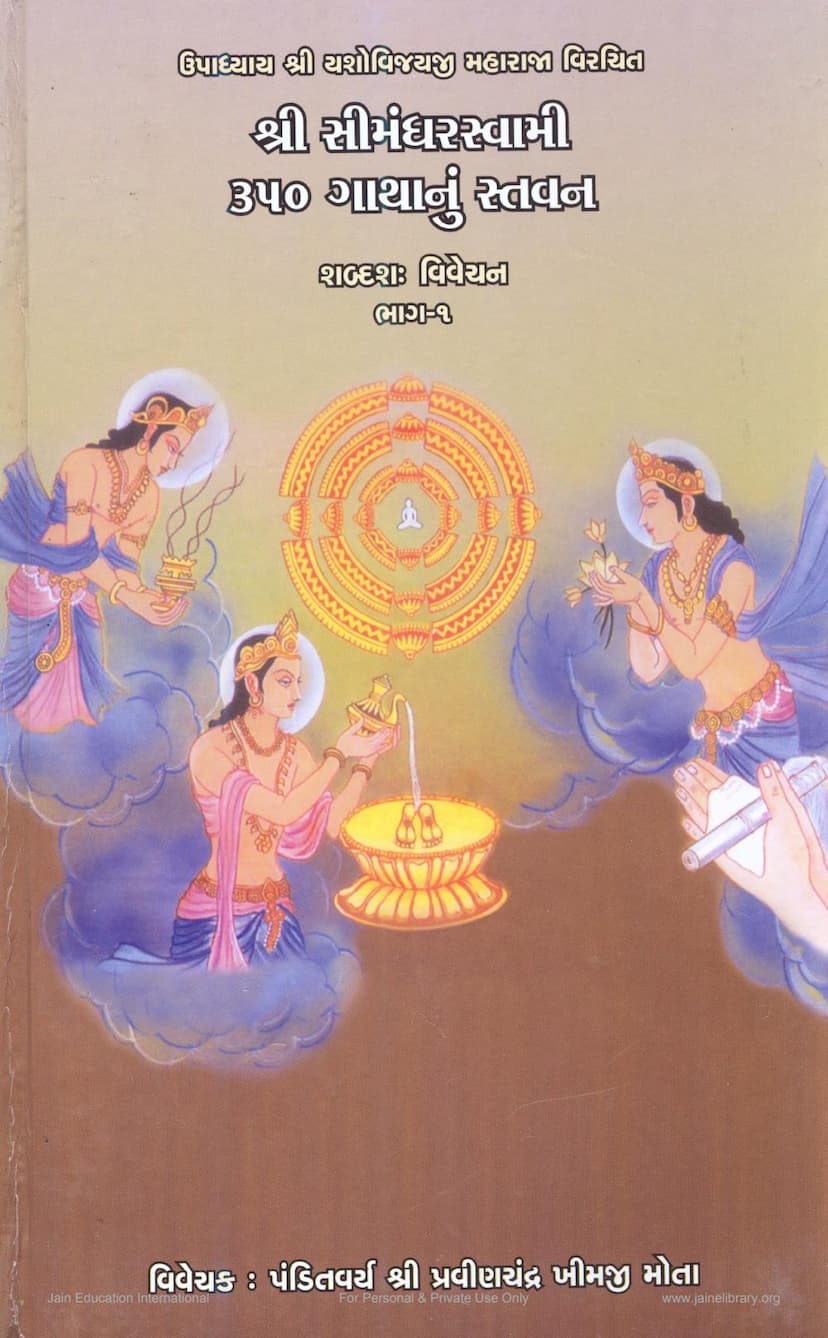Simandhar Swami 350 Gathanu Stavan Part 01
Added to library: September 2, 2025

Summary
Here's a comprehensive summary of the provided Jain text, "Simandhar Swami 350 Gathanu Stavan Part 01":
Book Title: Simandhar Swami 350 Gathanu Stavan Part 01 Author: Pravinchandra K Mota Publisher: Gitarth Ganga Original Author of the Stavan: Upadhyay Yashovijayji Maharaj Core Theme: The text is a detailed commentary (vivechan) on a 350-verse hymn (stavan) composed in a devotional and pleading style addressed to Lord Simandhar Swami. The primary aim of the hymn is to seek guidance on the true path of Jainism, contrasting it with various misguided practices and interpretations prevalent among some individuals and groups.
Key Aspects and Commentary:
The commentary meticulously breaks down the hymn by its different sections (dhals) and verses (gathas), offering a scholarly analysis of the original verses and their underlying philosophical meanings. The central arguments revolve around the correct understanding and practice of Jain principles, particularly focusing on:
-
The True Path vs. Misguided Practices:
- Critique of Hypocrisy and Incorrect Conduct: The text strongly criticizes those who outwardly profess Jainism but inwardly deviate from its core tenets. This includes individuals who act contrary to scriptural injunctions (sutras) and misrepresent the teachings.
- Rejection of Superficial Asceticism: It highlights the inadequacy of mere outward austerity or rigid adherence to rituals without the inner understanding and purification of the soul. The commentary emphasizes that true restraint (sanyam) comes from right knowledge and perception, not just external actions.
- Addressing Faulty Interpretations: The text refutes various incorrect beliefs and practices, such as:
- Reliance on flawed spiritual guides (kugurus).
- Blind faith and superstitions among the ignorant.
- Misguided interpretations of monastic conduct.
- Misunderstandings about the concept of ahimsa (non-violence), leading to the neglect of other essential practices like worship.
- The justification of deviation from scriptural norms due to the perceived difficulties of the current era (kaliyuga).
-
The Importance of Scriptural Authority and Interpretation:
- Primacy of Scripture (Sutra): The commentary consistently emphasizes the need to adhere to the original scriptures.
- Role of Interpretations (Niryukti, Bhashya, Tikka): It argues that while scriptures are paramount, the commentaries and interpretations by enlightened scholars (like Niryukti, Bhashya, Tikka) are crucial for understanding the nuances and correct application of scriptural teachings. The text criticizes those who dismiss these interpretations.
- The "Why" Behind Practices: The commentary stresses understanding the rationale and context behind religious practices, rather than blindly following them.
-
The Role of the Guru and Community (Gachh):
- Guidance of the Enlightened Guru (Gitaarth): The text strongly advocates for the necessity of following an enlightened spiritual guide (Gitaarth Guru) who possesses deep scriptural knowledge and practical wisdom. The Gitaarth Guru is presented as essential for navigating the complexities of the spiritual path and avoiding pitfalls.
- Importance of the Community (Gachh): It highlights the significance of the monastic community (Gachh) as a supportive environment for spiritual growth, where mutual guidance and reinforcement help in maintaining discipline and progress. The text warns against abandoning the community or isolating oneself without proper justification.
- Distinguishing True vs. False Gurus and Communities: The commentary provides criteria to identify true spiritual guides and communities, emphasizing their adherence to scripture and genuine spiritual progress, as opposed to mere outward appearances or popularity.
-
Key Concepts Discussed:
- Karma and its Consequences: The text touches upon the principle of karma and how actions, both positive and negative, lead to specific outcomes.
- Ahimsa (Non-violence): While recognizing ahimsa as a supreme principle, the text elaborates on its multifaceted nature, encompassing both physical and mental aspects, and its interconnectedness with other Jain vows and practices.
- The Importance of Inner State (Bhava) over Outer Actions: A recurring theme is the emphasis on the inner intention and spiritual state (bhava) as being more crucial than mere outward actions.
- Various Nayas (Perspectives): The commentary likely employs different Nayas (philosophical viewpoints) to interpret scriptural verses, demonstrating the depth and multifaceted nature of Jain philosophy.
- The Nature of Spiritual Progress: The text outlines the path towards liberation, emphasizing the gradual stages of spiritual development and the importance of continuous effort and adherence to the teachings of the Tirthankaras.
-
The Role of the Commentator and Publisher:
- The text acknowledges Panditvar Shri Pravinchandra Khimji Mota as the commentator, whose scholarly insights are crucial.
- Gitarth Ganga is credited as the publisher, dedicated to disseminating Jain scriptures and philosophical works.
- The text also thanks various individuals and spiritual leaders who provided blessings and support for the publication.
Overall Purpose:
The primary purpose of this work is to provide clarity on the authentic path of Jainism, addressing contemporary deviations and misconceptions. It aims to guide seekers towards a deeper and more accurate understanding of the teachings of Lord Simandhar Swami and the Jain Tirthankaras, encouraging sincere spiritual practice rooted in scriptural knowledge and the guidance of enlightened masters. The commentary serves as a valuable resource for understanding the original hymn and the intricate philosophical concepts within Jainism.